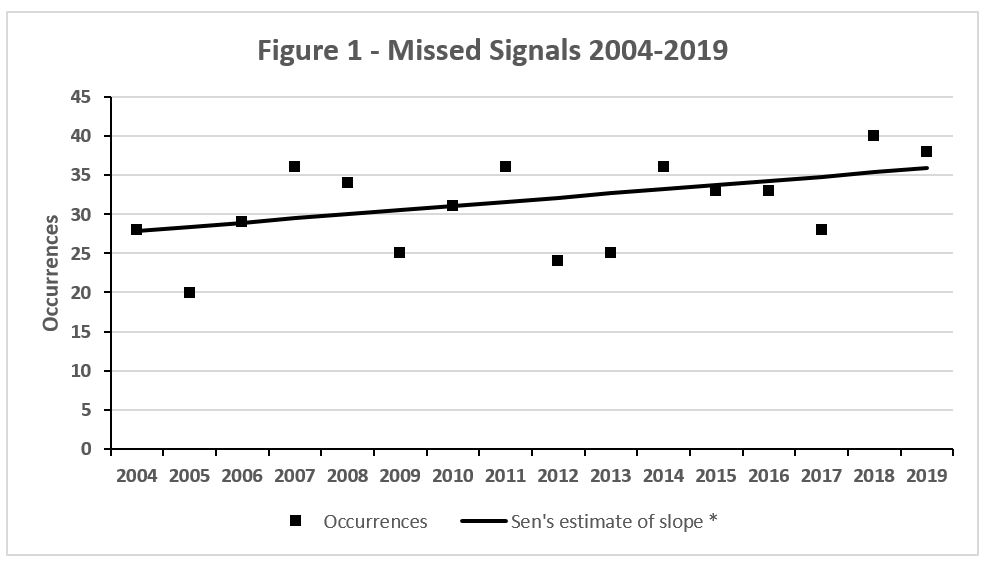Following railway signal indications
Train crews do not consistently recognize and follow railway signals. This poses a risk of train collisions or derailments, which can have catastrophic consequences.
The situation
For over a century, Canada has relied on a system of visual signals to control traffic on a significant portion of its rail network. These signals convey direction such as operating speed and the operating limits within which the train is permitted to travel. Train crews are required to identify and communicate the signal indications among themselves, and then take required action in how they operate the train.
Sometimes, however, train crews misinterpret or misperceive a signal indication, which results in it not being followed. In the absence of physical fail-safe defences, this could result in a collision or a derailment.
How often does this happen?
Since 2004, there has been an annual average of 31 reported occurrences in which a train crew did not respond appropriately to a signal indication displayed in the field, and the number of occurrences each year is on the rise. The years 2018 and 2019 have the highest number of occurrences, 40 and 38 respectively (Figure 1).
* Upward trend in the number of occurrences over the period (τb = 0.324, p 1-tailed = 0.0425). Sen’s estimate of slope is an unbiased estimator of the true slope of the trend line.
The risks to people, property, and the environment
This issue has been on the Watchlist since 2012. Although the probability of a missed signal leading to an accident may be low, the resulting train collision or derailment can have catastrophic consequences for people, property, and the environment.
Since 1990, the Transportation Safety Board of Canada (TSB) has investigated 79 occurrences that could have been prevented using a physical fail safe defence such as enhanced train control (ETC). These occurrences resulted in:
- 52 derailments (520 derailed rolling stock)
- 40 train collisions (of which 34 resulted in a derailment)
- 8 fatalities
- 316 injuries to employees and passengers
Outstanding TSB recommendations
Over the years, train signal misinterpretation or misperception has been cited as a cause or contributing factor in numerous rail investigations conducted by the TSB (TSB rail transportation safety investigation reports R98V0148, R99T0017, R07E0129, R09V0230, R10Q0011, R10V0038, R11E0063, R12T0038, R13C0049, R14T0294, R15D0118 R15V0183, R16E0051, R16T0162, and R18D0096). In the United States, the National Transportation Safety Board has investigated similar accidents and has concluded that additional physical defences are required (National Transportation Safety Board accident reports RAB-06-07, RAR-07-01, RAR-09-01, RAR-16-03, RAB-17-04, RAB-17-08 and RAB-19-02).
The TSB has made two recommendations on following railway signal indications,first in 2000 and again in 2013. Although Transport Canada (TC) and the railway industry are studying the issue, the work has not sufficiently advanced to indicate if, or when, additional physical safety defences will be implemented.
In February 2020, the Board reassessed the responses to Recommendation R00-04, which recommends the implementation of additional backup safety defences to help ensure that signal indications are consistently recognized and followed, and Recommendation R13-01, which calls for the implementation of physical fail-safe train controls, beginning with Canada's high-speed rail corridors. Both responses were assessed as being Satisfactory in Part. The Board expressed concern that, even though work is ongoing to define a roadmap for the adoption of ETC, no specific plan or timelines have been established for its implementation. Furthermore, the Board stated that no specific strategies, other than enforcement action (as required), are being used to address the risk of train collisions or derailments in the absence of additional backup safety defences.
Actions taken
Some railways in Europe have train control systems such as ETC that will provide an alarm in the locomotive cab if the train crew does not respond appropriately to a signal. Such a system still relies on the operating crew for compliance but can include “a static display of track infrastructure, speed limits and operating restrictions, and provide a dynamic display of current train location”Footnote 1 with audible or visual alarms but without positive enforcement. Positive train control (PTC)Footnote 2, where the system will stop a train if the train crew does not respond appropriately to a signal, is being implemented in the United States.
In Canada, while there are no ETC systems in use by federally-regulated freight or passenger railways, ETC technology has been implemented by many commuter rail services. In 2016, a joint TC–industry working group on train control produced a report entitled Train Control Working Group Final Report, which concluded that a targeted, risk-based, corridor-specific implementation of train control technologies would be the best option for Canada.
Although there has been work to define a roadmap for ETC adoption, TC has not formally indicated its policy direction, nor have any specific plans or timelines been established. Currently, in the absence of additional backup safety defences, there are no strategies (or interim measures) to address the risk of train collision or derailment (other than enforcement action after some occurrences).
While stakeholders in Canada continue to study the need for such systems, in the United States, both the Canadian National Railway Company (CN) and Canadian Pacific Railway (CP) have PTC implementation plans in order to meet Federal Railroad Administration mandatory requirements by 31 December 2020. Both CN and CP have equipped all of their locomotives with on-board systems and route miles with the required PTC equipment and, at 31 March 2020, were awaiting final approval by the Federal Railroad Administration for their respective systems. Neither CN nor CP intends to extend the use of PTC in Canada.
Action required
This issue will remain on the Watchlist until TC requires that railways implement additional physical safety defences to ensure that signal indications governing operating speed and operating limits are consistently recognized and followed.

